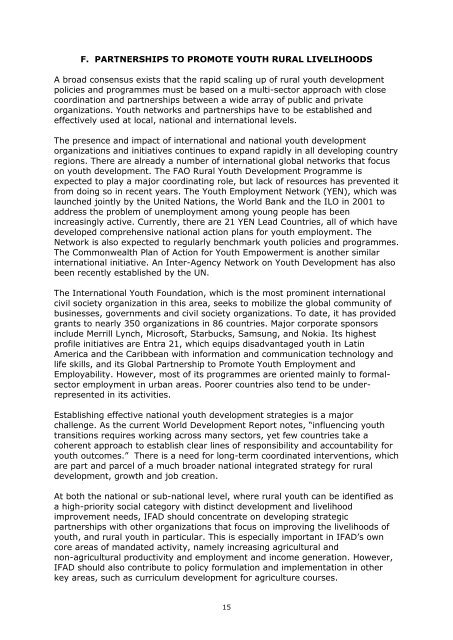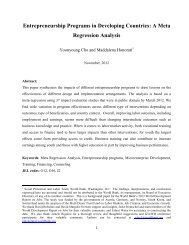Investing in the future: Creating opportunities for young rural ... - IFAD
Investing in the future: Creating opportunities for young rural ... - IFAD
Investing in the future: Creating opportunities for young rural ... - IFAD
Create successful ePaper yourself
Turn your PDF publications into a flip-book with our unique Google optimized e-Paper software.
F. PARTNERSHIPS TO PROMOTE YOUTH RURAL LIVELIHOODS<br />
A broad consensus exists that <strong>the</strong> rapid scal<strong>in</strong>g up of <strong>rural</strong> youth development<br />
policies and programmes must be based on a multi-sector approach with close<br />
coord<strong>in</strong>ation and partnerships between a wide array of public and private<br />
organizations. Youth networks and partnerships have to be established and<br />
effectively used at local, national and <strong>in</strong>ternational levels.<br />
The presence and impact of <strong>in</strong>ternational and national youth development<br />
organizations and <strong>in</strong>itiatives cont<strong>in</strong>ues to expand rapidly <strong>in</strong> all develop<strong>in</strong>g country<br />
regions. There are already a number of <strong>in</strong>ternational global networks that focus<br />
on youth development. The FAO Rural Youth Development Programme is<br />
expected to play a major coord<strong>in</strong>at<strong>in</strong>g role, but lack of resources has prevented it<br />
from do<strong>in</strong>g so <strong>in</strong> recent years. The Youth Employment Network (YEN), which was<br />
launched jo<strong>in</strong>tly by <strong>the</strong> United Nations, <strong>the</strong> World Bank and <strong>the</strong> ILO <strong>in</strong> 2001 to<br />
address <strong>the</strong> problem of unemployment among <strong>young</strong> people has been<br />
<strong>in</strong>creas<strong>in</strong>gly active. Currently, <strong>the</strong>re are 21 YEN Lead Countries, all of which have<br />
developed comprehensive national action plans <strong>for</strong> youth employment. The<br />
Network is also expected to regularly benchmark youth policies and programmes.<br />
The Commonwealth Plan of Action <strong>for</strong> Youth Empowerment is ano<strong>the</strong>r similar<br />
<strong>in</strong>ternational <strong>in</strong>itiative. An Inter-Agency Network on Youth Development has also<br />
been recently established by <strong>the</strong> UN.<br />
The International Youth Foundation, which is <strong>the</strong> most prom<strong>in</strong>ent <strong>in</strong>ternational<br />
civil society organization <strong>in</strong> this area, seeks to mobilize <strong>the</strong> global community of<br />
bus<strong>in</strong>esses, governments and civil society organizations. To date, it has provided<br />
grants to nearly 350 organizations <strong>in</strong> 86 countries. Major corporate sponsors<br />
<strong>in</strong>clude Merrill Lynch, Microsoft, Starbucks, Samsung, and Nokia. Its highest<br />
profile <strong>in</strong>itiatives are Entra 21, which equips disadvantaged youth <strong>in</strong> Lat<strong>in</strong><br />
America and <strong>the</strong> Caribbean with <strong>in</strong><strong>for</strong>mation and communication technology and<br />
life skills, and its Global Partnership to Promote Youth Employment and<br />
Employability. However, most of its programmes are oriented ma<strong>in</strong>ly to <strong>for</strong>malsector<br />
employment <strong>in</strong> urban areas. Poorer countries also tend to be underrepresented<br />
<strong>in</strong> its activities.<br />
Establish<strong>in</strong>g effective national youth development strategies is a major<br />
challenge. As <strong>the</strong> current World Development Report notes, “<strong>in</strong>fluenc<strong>in</strong>g youth<br />
transitions requires work<strong>in</strong>g across many sectors, yet few countries take a<br />
coherent approach to establish clear l<strong>in</strong>es of responsibility and accountability <strong>for</strong><br />
youth outcomes.” There is a need <strong>for</strong> long-term coord<strong>in</strong>ated <strong>in</strong>terventions, which<br />
are part and parcel of a much broader national <strong>in</strong>tegrated strategy <strong>for</strong> <strong>rural</strong><br />
development, growth and job creation.<br />
At both <strong>the</strong> national or sub-national level, where <strong>rural</strong> youth can be identified as<br />
a high-priority social category with dist<strong>in</strong>ct development and livelihood<br />
improvement needs, <strong>IFAD</strong> should concentrate on develop<strong>in</strong>g strategic<br />
partnerships with o<strong>the</strong>r organizations that focus on improv<strong>in</strong>g <strong>the</strong> livelihoods of<br />
youth, and <strong>rural</strong> youth <strong>in</strong> particular. This is especially important <strong>in</strong> <strong>IFAD</strong>‟s own<br />
core areas of mandated activity, namely <strong>in</strong>creas<strong>in</strong>g agricultural and<br />
non-agricultural productivity and employment and <strong>in</strong>come generation. However,<br />
<strong>IFAD</strong> should also contribute to policy <strong>for</strong>mulation and implementation <strong>in</strong> o<strong>the</strong>r<br />
key areas, such as curriculum development <strong>for</strong> agriculture courses.<br />
15

















